
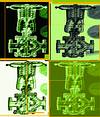
Suitable materials and proper control valve sizing can minimise the wear on a process plant’s control valves. Depending on the importance of the control loop for the process, additional process automation measures can minimise the impact of unexpected control valve failure.
A certain amount of wear on components is only natural, despite all the design measures. Preventive maintenance methods, including servicing, inspection and repair, are aimed at maintaining or restoring the design condition of a technical installation. Service routines are carried out in order to preserve the operability of the equipment. Repair jobs serve to re-establish its design condition.
A major aspect of maintenance is the evaluation of the actual wear and the remaining service life of the parts (Figure 1). Accurate data regarding the actual state of the equipment can only be gained from inspections. Unnecessary disassembly of instruments, or omitted component replacements and subsequent failure of the equipment, entail considerable costs. This article describes opportunities presently available for state-oriented maintenance, taking the example of a pneumatic control valve.
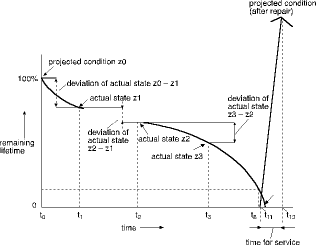
Failure analysis
The fundamental question is which types of wear occur and how unnecessary control-valve disassembly can be avoided by using a 'smart' valve positioner. If we consider a control valve that consists of a body, an actuator and a positioner, the main target for wear will be the valve body due to its direct contact with the medium. In particular, the throttling area with the seat and plug is affected by the pressure drop, high temperatures, abrasive media and corrosion. The result is an increasingly high leakage rate caused by wear at the throttling element's sealing joints, leading finally to a modified flow characteristic. At worst, the plug stem could break down, resulting in the immediate failure of the control valve. In connection with plug wear, the plug stem could also be affected at the guiding area. The result would be greater frictional forces and consequently an increasing hysteresis of the control valve.
Like the plug sealing joints, the seat sealing joints can be affected by wear, along with the seat to body sealing, especially in conjunction with cage retained designs that include an inserted gasket. Both types of wear result in increased internal leakage rates.
Another critical element is the stuffing box intended for sealing the stem off from the surrounding air. Toxic or environmentally harmful media especially must be prevented from escaping into the atmosphere. The stem sealing for these media usually consists of double seal, eg, a bellows seal with a safety stuffing box. As shown in Figure 2, the expected service life of bellows seals for control valves is usually calculated to correspond to 100000 cycles of nominal travel under nominal pressure.
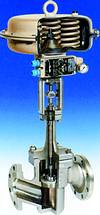
Under normal operating conditions, however, a control valve only operates within a certain part of its nominal travel, so that the service life increases exponentially. The exact service life of a bellows seal can only be determined by means of random tests during a test cycle.
While a bellows seal guarantees 100% tightness during its service life, there will always be a slow but steady increase in the leakage rate of the stuffing box. In particular, adjustable stuffing boxes exhibit a continuously rising leakage rate due to the decreasing compression of the packing during operation. The compression forces are limited, however, in that they cause the frictional forces to increase: as a result, the control valve hysteresis also increases considerably.
Modern, self-adjusting packings, such as PTFE chevron rings, are characterised by significantly better tightness than adjustable packings as well as by substantially lower friction values, ie, reduced hysteresis. Changes in the friction values/hysteresis are ruled out, because the compression is maintained by a spring. It is therefore impossible to draw conclusions about the state of the packing from the hysteresis curve measured for a control valve.
The valve body and bonnet are also subject to a certain amount of wear. Erosion caused by the flow, especially under cavitation conditions, and excavation due to corrosion are the main agents. These can also affect the sealing surfaces of the connecting flanges for the pipework.
Failure of actuator and positioner
In the case of pneumatic actuators, failures are generally caused by wear occurring at the diaphragm, the springs or the actuator stem sealing. In rare instances, the actuator housing or the diaphragm plate may fail.
A defective stem sealing will lead to an increase in the air consumption of the actuator, and will not be detected until the positioner stops supplying a sufficient amount of air. This will slowly increase the actuating time of the valve. Similar results can be expected from a defective diaphragm, except that a critical leakage rate may be reached much faster, eg, due to a rupture of the diaphragm. It rarely happens that actuator springs fail, since this can be easily prevented by using properly tested spring designs (fatigue endurance limit). In the event of a spring failure, however, the actuator force is reduced.
With actuators featuring one central spring, the actuator force instantly drops to zero, so that the valve cannot be moved in a defined fail-safe position, however, is the loss of only 15 to 20% of the forces, which is usually covered by the safety factor in the actuator sizing. The internal leakage rate is the closed position of the valve may increase, due to the reduced actuator force. If the positioner fails, the interface between the DCS system and the control valve is no longer available, leading to an immediate control loop failure. A shift in the zero point eg, owing to contaminated instrument air or temperature drift, may cause an increase in the internal leakage rate of a reduction in the flow capacity of the valve.
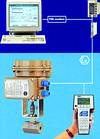
Possible diagnostic routines
The availability of smart positioners and the possibility of bidirectional data exchange between the control room and the field, open up new ways for users to enhance their maintenance programs. Implementing the proper methods and algorithms allow them to analyse the actual state of a control valve. Today, data can be exchanged either using the HART protocol for analog instrumentation or via the fieldbus in digital environments (Figure 3). The HART protocol uses the conventional wires of the 4...20 mA signal and superimposes a sine signal for digital data transmission. The technique has the advantage that it makes use of conventional process-control instrumentation. Fieldbus technology, eg, Profibus-PA, uses digital signals to transmit control signals, configuration data and status information (Figure 4).
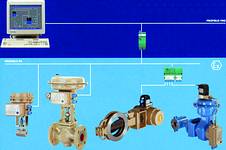
In addition to reduced planning, wiring, documentation and hardware expenses, fieldbus system technology has superior functionality and higher data transmission rates as compared to conventional wiring technology, thus facilitating improved analysis of the control valve's dynamic response.
Due to the limited supply energy available when powering the positioner with 'live zero' signals or via the bus, smart positioners must be equipped with special low-power microelectronic components. The interface to the pneumatic system in particular is required to make a great effort in order to supply the actuator with sufficient air. This is usually accomplished by installing solenoid valves which are operated in a pulse-width modulated algorithm.
At the same time, the control algorithm serves to monitor the positioner's performance and indicate malfunctions. A predefined tolerance band and delay time enable the control loop's step response to be monitored. Some of the defects mentioned above, such as increased friction in the guide bushings, jamming of the plug or a defect in the actuator, may cause the delay time to be exceeded (Figure 5). Reduced air supply pressure may also cause a loop error, since the control valve cannot move into the desired position. This error generates a binary output signal via a hardware contact in accordance with DIN 19234 as well as a status message via the communication link. In order to support additional maintenance routines, the positioner is equipped with a travel counter, which adds up the number of cycles so far and indicates the remaining service life of the packing or bellows seal. The updated number of performed cycles is compared to a statistical failure rate. If the number of performed cycles exceeds this limit value, a hardware alarm will be tripped and a status message issued via the communication interface. The user thus received alarm messages before the component fails, enabling him to schedule his maintenance jobs on time.
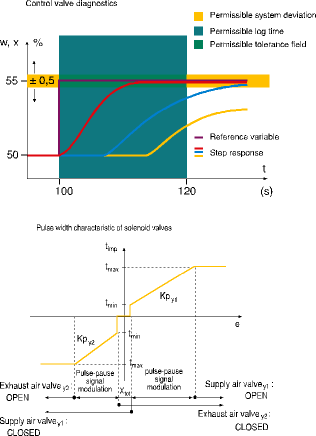
Data concerning the wear on the plug sealing joints can only be obtained in the closed position of the valve. The precise travel pick-off system of the positioner detects a shift in the zero point, which indicates wear on the seat or the plug sealing joints. The communication software's graphical user interface (IBIS or Cornerstone) indicates when 'negative travel' occurs. In spite of this accurate travel indication method, there are certain limitations, since very small traces of wear on the sealing joints cannot be detected, yet they may already cause an unacceptable leakage rate in the closed position. This information can only be acquired with additional flow sensors.
Further advantages of digital data processing
The positioner's internal digital data processing routine enables a fully automated start-up. During this initialisation procedure, the entire pneumatic system, ie, the signal pressure line and the actuator, is checked for tightness. In case of a pneumatic leakage that exceeds the maximum permissible value, the positioner aborts the start-up procedure and generates an error message. During the initialisation routine, the geometric relationship is also checked, thus revealing deviations between the nominal travel and the actual travel.
Another advantage of digital data processing is the long-term stability of the zero and span. Since this data is processed digitally, a zero shift, eg, due to temperature drifting or ageing, can be excluded. Thanks to the configurable tight-closing function, the actuator can be fully vented when a predefined reference variable is reached, so that the full actuator force is available. This ensures that only control valves with a defective plug, and not merely and decalibrated positioner, are opened for inspection and disaasembled for maintenance.
Additional information on the control valve status can be obtained by analysing the dynamic response, typical failure patterns can be identified and possible failures diagnosed without having to install additional sensors.
The step response of a control valve is essentially made up of the delay time and the transit time. The variations in the delay time and transit time permit increased friction values, a reduced supply pressure, broken actuator springs or clogged air filters to be diagnosed. Diagnostic PC software enables the user to identify possible wear locations by comparing the initial step response to the updated step response: direct instructions are then issued regarding which maintenance routines to initiate.

© Technews Publishing (Pty) Ltd | All Rights Reserved